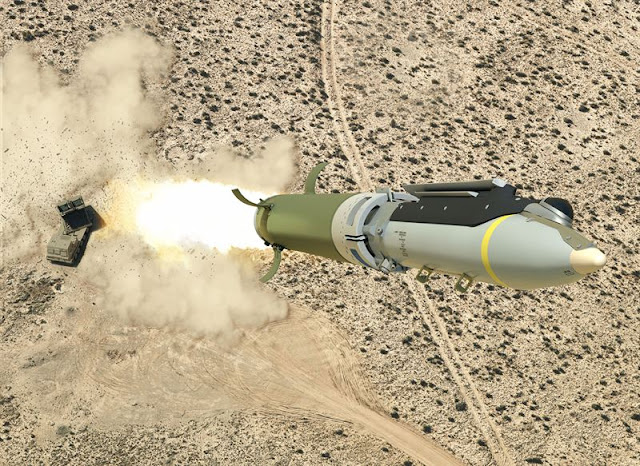Saab has unveiled a series of new Concepts of Operation (CONOPS) for the GBU-39/B Small Diameter Bomb (SDB) with a novel design now allowing the munition to be launched from ground-vehicles.
Speaking to MT ahead of the Farnborough International Air Show, scheduled to take place between 11-15 July, Alex Alderson, UK Marketing Sales Director for the company’s Land Portfolio, explained how the GBU-39/B SDB had been re-roled from an airborne-delivered munition to one capable of supporting operations from the ground.
Being specifically developed with Boeing for the US Army’s Missile Technology Demonstration, the Ground Launched SDB (GLSDB) has been designed on the back of precision-guided munitions utilised for Counter-Insurgency (COIN) operations in Afghanistan, Iraq and elsewhere over the past decade or so.
However, Alderson explained how the Contemporary Operating Environment was starting to witness evolving requirements for the same precision but with enhanced reach, particularly as modern threats trend away from Low Intensity Conflict and potentially further towards more High Intensity Conflict with “Near Peer” adversaries such as Russia, China and North Korea.
As Alderson explained, armed forces now require extended reach in order to neutralise high priority targets in multiple engagements.
The re-roled armament now comprises the GBU-39/B SDB munition; MLRS Rocket motor; and an Interstage Adapter, the latter of which can be pre-programmed to detach and fall to the ground in a pre-determined square kilometre box. The munition can be fired from legacy MLRS platforms, thereby reducing the amount of extra retraining for soldiers.
“The GLSDB increases the capabilities of MLRS and brings the SDB into the land domain,” Alderson explained.
“GLSDB provides commanders and planners with a flexible weapon which complements existing ballistic trajectory weapons. The SDB is a 250-pound class weapon with an Advance Anti-Jam Global Positioning System-aided Intertial Navigation System, combined with a multipurpose penetrating blast-and-fragmentation warhead and a programmable electronic fuze,” company literature explained.
The munition is accurate to within a single metre, Saab claimed, with the weapon system being capable of launch in all weather conditions during the day and night. It also features terrain avoidance technology to allow manoeuvre around mountains and other obstacles as well as a cave breaching capability.
A programmable fuze can also be used for impact and delay fuzing for deep penetration or proximity height-of-burst while a SDB Focused Lethality Munition (FLM) variant is also an option for low collateral damage. The munition is also capable of destroying moving targets.
The concept has also extended the range of the weapon system out to 150km for targets to the front of the launcher while firing from the same position, rockets are capable of engaging targets up to 70km to the rear; and 115km to each flank. Alderson highlighted how legacy and other in-service capabilities boasted ranges out to approximately 70km.
The GLSDB is capable of firing from out-of-sight and protected areas with a “Ripple Fire” capability should one be required for the engagement and suppression of multiple targets. The weapon system is also capable of providing 360-degree coverage without any requirement to manoeuvre the launcher. The munition alos lacks a minimum engagement range, Alderson added.
"GLSDB is a long range precision incendiary solution that widens the capabilities of armed forces. Capable of conducting reverse slope engagements and defeating a range of targets, from hardened facilities to soft-skinned assets, the GLSDB adds another dimension to armed forces´ capabilities,” company literature read.
Alderson also highlighted how the GLSDB could be used to counter tall buildings encountered during Military Operations in Urban Terrain (MOUT) with options available to conduct steep attack firings for Non-Line of Sight (NLOS) targets through to near-horizontal engagements more suitable for rural fire missions.
“For ground forces, GLSDB now provides the same precision strike capability currently only provided by Air Forces,” Alderson highlighted. “GLSDB therefore reduces requirements to call upon additional air assets and close air support.”
The capability was demonstrated in February 2015 at the Vidsel Test Range in Sweden with a Live Fire Serial. Since then, GLSDB has been verified and validated for integration on board the MLRS Rocket Launcher.
Alderson explained how the next stage of the programme would see variants supplied for the US Army’s Missile Technology Demonstration programme although he was unable to comment on when an expected trials programme would be conducted.
Finally, Saab also admitted it was considering maritime concepts of operation for the SDB with a Maritime Launched SDB (MLSDB) used for precision Naval Gunfire Support (NGS) missions during littoral and amphibious operations for example.
